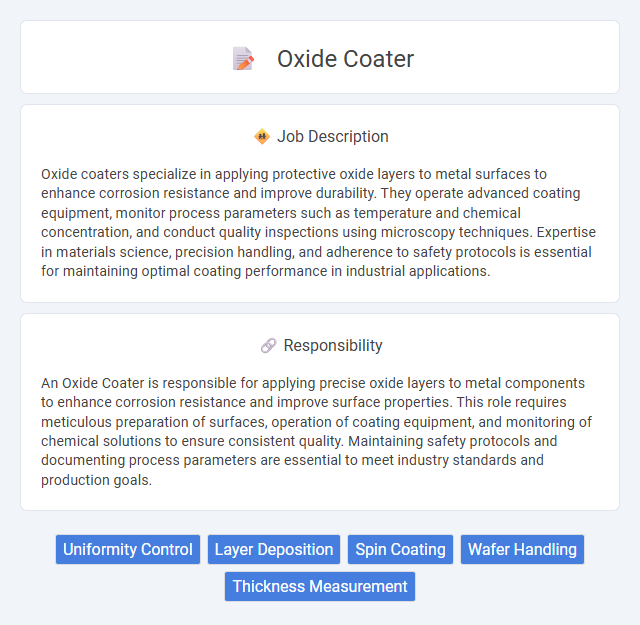
Oxide coaters specialize in applying protective oxide layers to metal surfaces to enhance corrosion resistance and improve durability. They operate advanced coating equipment, monitor process parameters such as temperature and chemical concentration, and conduct quality inspections using microscopy techniques. Expertise in materials science, precision handling, and adherence to safety protocols is essential for maintaining optimal coating performance in industrial applications.
People with good hand-eye coordination and attention to detail are likely suitable for an oxide coater job, as the role involves applying protective oxide layers precisely. Candidates who are comfortable working in environments with chemicals and can follow safety protocols may have a higher probability of performing well. Those with physical stamina to stand for extended periods might find this position more fitting.
Qualification
An Oxide Coater typically requires a high school diploma or equivalent, with specialized training or certification in chemical processing or industrial coating methods preferred. Proficiency in operating coating equipment, understanding chemical safety protocols, and experience in quality control are essential for ensuring consistent oxide layer applications on metal surfaces. Strong attention to detail and knowledge of material science, especially oxidation processes, enhance job performance and workplace safety.
Responsibility
An Oxide Coater is responsible for applying precise oxide layers to metal components to enhance corrosion resistance and improve surface properties. This role requires meticulous preparation of surfaces, operation of coating equipment, and monitoring of chemical solutions to ensure consistent quality. Maintaining safety protocols and documenting process parameters are essential to meet industry standards and production goals.
Benefit
An oxide coater role likely offers benefits including enhanced protection for metal surfaces against corrosion, which may extend the lifespan of industrial equipment. This position probably supports improved electrical insulation properties, contributing to higher efficiency in electronic components. The job could also provide opportunities for skill development in advanced coating technologies, increasing future career prospects.
Challenge
Working as an Oxide coater likely involves challenges related to maintaining precise control over coating thickness and consistency to ensure product quality. There may be frequent troubleshooting of equipment malfunctions or variations in chemical composition, posing risks to workflow efficiency. The role probably demands vigilance in adhering to safety protocols due to exposure to hazardous materials during the coating process.
Career Advancement
An oxide coater plays a critical role in industrial manufacturing by applying uniform oxide layers to metal surfaces, enhancing corrosion resistance and durability. Mastery of coating techniques and quality control allows professionals in this field to advance to supervisory or technical expert positions within production teams. Continued education in materials science and process automation can lead to roles in research and development or management, significantly expanding career opportunities.
Key Terms
Uniformity Control
Oxide coaters specialize in applying uniform oxide layers on various metal surfaces to enhance corrosion resistance, electrical insulation, and surface hardness. Precision in uniformity control is critical, achieved through regulating process parameters such as temperature, humidity, and chemical concentration to ensure consistent oxide film thickness across all substrates. Advanced inspection technologies like ellipsometry and surface profilometry verify layer uniformity, guaranteeing optimal performance of the coated components in industrial applications.
Layer Deposition
An Oxide coater specializes in the precise deposition of oxide layers on semiconductor wafers, ensuring uniform thickness and optimal material properties for electronic device performance. Utilizing techniques such as chemical vapor deposition (CVD) or atomic layer deposition (ALD), oxide coaters control parameters like temperature, gas flow, and pressure to achieve superior film quality. Expertise in layer deposition directly impacts the electrical insulation, surface passivation, and overall durability of microelectronic components.
Spin Coating
Spin coating is a precise thin film deposition technique widely utilized in oxide coating applications to achieve uniform layers on substrates. This method involves dispersing a liquid precursor onto a rotating substrate, leveraging centrifugal force to form consistent oxide films crucial for semiconductor, photovoltaic, and sensor industries. Mastery of spin speed, solution viscosity, and drying parameters directly impacts the oxide layer's thickness, uniformity, and overall performance.
Wafer Handling
Oxide coaters specializing in wafer handling are responsible for precisely applying oxide layers to semiconductor wafers using advanced chemical vapor deposition (CVD) and plasma-enhanced chemical vapor deposition (PECVD) techniques. Expertise in automated wafer loading, alignment, and unloading systems ensures minimal contamination and high uniformity in oxide films critical for device performance. Proficiency with cleanroom protocols and real-time process monitoring enhances yield and reduces defects in semiconductor manufacturing.
Thickness Measurement
An Oxide Coater specializing in Thickness Measurement ensures precise control over oxide layer deposition in semiconductor and industrial applications, utilizing advanced metrology tools like ellipsometers and profilometers. Accurate thickness measurement is critical for maintaining product quality, optimizing coating uniformity, and meeting strict industry specifications such as those in microelectronics and automotive manufacturing. Expertise in process calibration, data analysis, and adherence to cleanliness standards guarantees consistent oxide film performance and device reliability.
 kuljobs.com
kuljobs.com